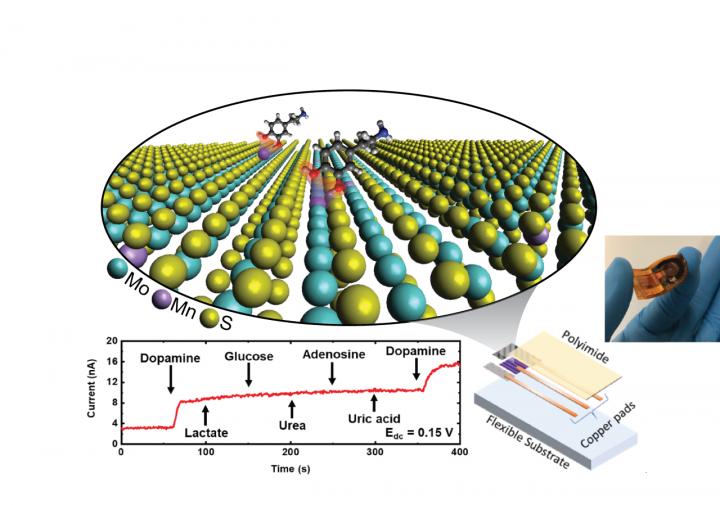
Credit: Derrick Butler, Penn State
A supersensitive dopamine detector can help in the early diagnosis of several disorders that result in too much or too little dopamine, according to a group led by Penn State and including Rensselaer Polytechnic Institute and universities in China and Japan.
Dopamine is an important neurotransmitter that can be used to diagnose disorders such as Parkinson’s disease, Alzheimer’s disease and schizophrenia.
“If you can develop a very sensitive, yet simple-to-use and portable, detector that can identify a wide range of dopamine concentration, for instance in sweat, that could help in non-invasive monitoring of an individual’s health,” said Aida Ebrahimi, assistant professor of electrical engineering, Penn State, and a corresponding author on a paper published Aug. 7 in Science Advances.
Their work shows that by adding a small amount of manganese to a two-dimensional layered material called molybdenum disulfide, they can improve the sensitivity by many orders of magnitude compared to other reported results, while also achieving high specificity. Importantly, their detector is low-cost and flexible, and can detect dopamine in background media including buffer, serum and sweat, and in real-time.
“Regarding our method, electrochemical deposition is a new way of depositing these chemicals that is very simple and scalable,” said Mauricio Terrones, Verne M. Willaman Professor of Physics, Materials Science and Chemistry and the second corresponding author. “The air force is interested in these neurotransmitters that are makers of stress. I envision this as a wearable sensor.”
Humberto Terrones and his group, at RPI, performed the computational investigation that allowed them to explain how addition of manganese results in an improved response to dopamine. The experimental work was performed within the Center for Atomically Thin Multifunctional Coatings (ATOMIC) at Penn State.
“Combining the experimental results with computational studies proved to be very insightful, and I think we all learned much more throughout this project because of that,” said Derrick Butler, a co-lead author on the paper and doctoral student at Penn State. “Developing these materials and applying them in a way that could improve the health and well-being of others makes the work especially enjoyable and rewarding.”
His co-lead author, doctoral candidate Yu Lei, added, “One challenge is to develop a scalable method to bridge fundamental studies and practical applications. Our method is based on electrodeposition, which has been widely used in industry, thus providing a scalable route to functionalize MoS2 in a scalable way. Also, I believe this multidisciplinary team is the key to find the right way to functionalize MoS2 for ultrasensitive dopamine detection.”
In further work, the group hopes to find other material combinations to detect a variety of other biomarkers with the specificity of their current sensor. Creating such a “toolkit” combining experimental investigations with computational methods will lead to new materials with multifunctional capabilities. This might be useful beyond human health, for example, for detecting noxious gases, water contamination or biodefense agents.
“In future, we can envision a combined sensor/actuator that can detect the dopamine and provide therapy at the same time. The sensors can be integrated with miniaturized chips for integration of sensing, actuating, control and data processing,” Ebrahimi said.
###
In addition to Ebrahimi, Lei, Butler and the Terrones brothers, authors include Fu Zhang and Tomotaroh Granzier-Nakajiwa, former or current doctoral students at Penn State, and Kazinora Fujisawa, currently a post-doctoral scholar, Penn State. Their paper is titled “Single-Atom Doping of MoS2 with Manganese Enables Ultrasensitive Detection of Dopamine: Experimental and Computational Approach.”
National Science Foundation, IUCRC-ATOMIC Center and Ebrahimi’s Start-up fund provided support for this project.
Terrones can be contacted at [email protected], and Ebrahimi can be contacted at [email protected].
Media Contact
A’ndrea Elyse Messer
[email protected]




